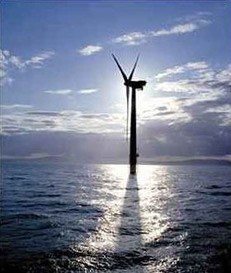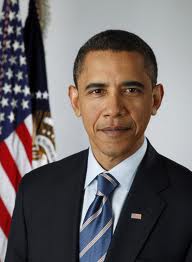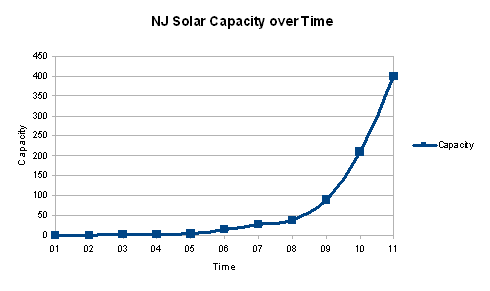 Tweet
Tweet

“Join me in setting a new goal: By 2035, 80 percent of America’s electricity will come from clean energy sources.” – President Barack Obama, State of the Union, January 25, 2011.
 When a mouse makes noise, only other mice and local cats take notice. When a lion roars, however, everyone notices; other lions, elephants, zebras, gazelles, smaller cats, mice ….
When a mouse makes noise, only other mice and local cats take notice. When a lion roars, however, everyone notices; other lions, elephants, zebras, gazelles, smaller cats, mice ….
New Jersey is one of 27 states, which, like the District of Columbia, have a Renewable Portfolio Standard, or RPS, mandating that by a certain date, a specific target of a renewable energy capacity will be deployed. An additional five states have non-binding goals. (This are listed by the U. S. Dept. of Energy at Energy Efficiency and Renewable Energy.)
In New Jersey the RPS is 22.5%, about 1.6 gigawatts (GW), by 2021. New Jersey today, in January, 2011, has about 300 megawatts of renewable energy capacity.  I am confident that New Jersey will meet, and possibly exceed its RPS goal. We started with 9.0 kilowatts (KW) of photovoltaic solar in 2001. We were up to 211 megawatts (MW), by the end of September, 2010, and we added an additional 24 MW in December, 2010. Even when you factor in 30 MW of biomass, 8 mw of wind power, and 1.5 mw of fuel cells, this is less than 20% of the goal of 1.6 gw. (This is shown at the NJ Clean Energy Program Renewable Energy Technologies page.) However paradigm shifts are systems phenomena. They occur at exponential rates. We went from 9.0 kw in 2001 to 211 mw in mid-2010, to 360 mw by the end of 2010. In December, 2010, we added an additional 10% – moving from 236 mw to 260 mw. We are hitting the handle of the hockey stick.
I am confident that New Jersey will meet, and possibly exceed its RPS goal. We started with 9.0 kilowatts (KW) of photovoltaic solar in 2001. We were up to 211 megawatts (MW), by the end of September, 2010, and we added an additional 24 MW in December, 2010. Even when you factor in 30 MW of biomass, 8 mw of wind power, and 1.5 mw of fuel cells, this is less than 20% of the goal of 1.6 gw. (This is shown at the NJ Clean Energy Program Renewable Energy Technologies page.) However paradigm shifts are systems phenomena. They occur at exponential rates. We went from 9.0 kw in 2001 to 211 mw in mid-2010, to 360 mw by the end of 2010. In December, 2010, we added an additional 10% – moving from 236 mw to 260 mw. We are hitting the handle of the hockey stick.
California’s RPS is 33% by 2030. In Texas, the RPS calls for 5,880 MW by 2015. California , New Jersey and Texas are the roaring mice in domestic US clean energy policy. And a cat – the lion in the Oval Office – the President of the United States – has listened to the mice in California, New Jersey, and Texas. Last night he roared.

Courtesy of the White House.
In his “State of the Union” address, January 25, 2011, President Obama set a lofty goal: “80% clean electric generation by 2035.” While I think we can do better – 100% clean renewable sustainable energy by 2025 – Obama’s goal is specific, measurable, achievable, realistic, and time-bound. It’s SMART. It’s also wise.
As a President should, Obama is thinking, and thinking long term. We at Popular Logistics wish him success because success for a President means a better future for the nation.
–
Two observations.
- There is no such thing as “Clean Coal.” Even if we capture and sequester all the carbon dioxide produced from burning coal, which is expensive, there are still impurities, such as arsenic, lead, mercury, uranium, zinc in coal. And mining and processing coal is a very dirty business.
- Nuclear is heavily regulated. We exercise tighter control over the wastes. In practice, nuclear power is arguably cleaner than coal. But in reality, things happen.
One question is “Can we achieve Obama’s Clean Electricity Goal?” But a better question is “How can we achieve this goal? ” My back of the envelope response is:
- 100 gigawatts offshore wind,
- 100 gigawatts land based wind,
- 50 gigagwatts solar,
- 75 gigawatts stored micro-hydro or biofuel, for when the sun isn’t shining and the wind isn’t blowing.
And as Amory Lovins, of the Rocky Mountain Institute, says, “The cheapest unit of energy is the ‘Negawatt’ – the energy you don’t have to buy.” How much can we reduce our energy requirements? How much can we gain by conservation?




